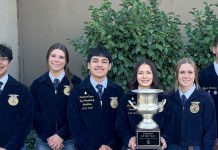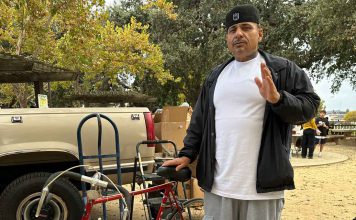Gilroy High School’s trophy case boasts many athletic victories
and it aims to add another prize, this time in academics.
Also with this story: sample tests in English, math, science and
history for multiple grades.
Also check out: sample tests in English, math, science and history for multiple grades to the right of this story.
Gilroy High School’s trophy case boasts many athletic victories and it aims to add another prize, this time in academics.
San Benito High School has challenged GHS to a test of wits by seeing which school will come out on top in the statewide tests that began today. Instead of comparing percentages of proficient or advanced students on the variety of subject areas assessed by the tests, the schools are aiming to show more growth than the other this year.
“They know we wouldn’t have accepted that challenge!” GHS principal James Maxwell said, explaining why the competition was based on growth rather than percentage points. “They’re already ahead of us in four of the five areas.”
The major subject areas cover language arts, mathematics, science and history.
Gilroy’s schools use a number of tactics to prepare student for the annual state tests. GHS counselors met with the majority of ninth through 11th graders individually to review past scores and help set future goals, Maxwell said. Las Animas Elementary will kick off its round of tests at 1 p.m. Thursday with a pep rally to pump students up, with guest appearances by Robert “the Ghost” Guerrero and the GHS cheerleaders. Last year, South Valley Middle School teachers wore T-shirts as reminders of the school’s goal.
“We are feeling very positive,” Superintendent Deborah Flores said. “We take the state guidelines very seriously and have implemented many interventions as a result. The strategies the schools put in place this year should increase the scores on the (California Standards Test).”
Currently, there are two accountability systems in California, the state model and the federal model. State Superintendent of Public Instruction Jack O’Connell likened the state’s Academic Performance Index, a measure of growth and improvement, to a long jump, while comparing the federal accountability model to a high jump. The statewide API provides a yardstick for measuring school performance on a scale of 200 to 1000. It is based on a school’s year-to-year improvement with a target score of 800. Meanwhile, the federal accountability model under No Child Left Behind allows states to set a bar of proficiency that must be met by all schools and subgroups. Under NCLB, 100 percent of students should reach that bar by 2014.
To succeed on the API, GHS, which earned a score of 705 on last year’s tests, needs to grow by about 5 points, according to the API formula. To succeed on the AYP, 35 percent of its students must prove to be at the proficient or advanced level this year.
Last year, GHS did not make either of the targets. However, because only schools that receive federal funds for having a significant percentage of socioeconomically disadvantaged students are disciplined for not reaching these goals, GHS was not penalized. But just because there aren’t consequences from the federal government for not reaching API and AYP doesn’t mean that schools don’t try to go above and beyond these goals anyway, said Rob Van Herk, director of assessment and data systems for the district.
“We want to make 35 percent not because the state mandates it, but because we want the kids to be proficient,” he said.
Maxwell hopes that the competition with San Benito will inspire the students to reach their full potential, he said.
“It’s very important for the kids to do well,” he said. “Parents have a right to know if their kids are learning in school. They’re paying for this exam.”
Schools won’t receive the results of the testing until August. Just in time for next school year, Van Herk said.
“We want to grow more than they grow,” Maxwell said. He hopes to see an academic trophy firmly situated in the GHS trophy case come August.
California Department of Education website.














